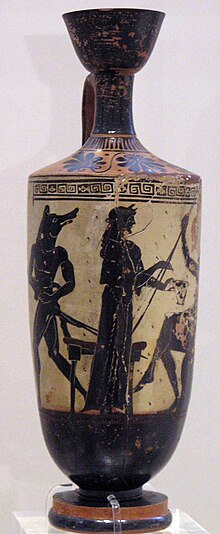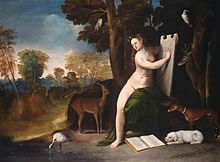Kirke
Kirke ( ancient Greek Κίρκη , Latinized Circe , from it Zirze , which shows the traditional German pronunciation) is a sorceress of Greek mythology . She is the daughter of the sun god Helios and the Oceanid Perse and the sister of King Aietes of Colchis and the Pasiphaë . Medea is her niece.
myth
Odyssey

( Lekythos by the Athena Painter , Eretria , around 480 BC, National Archaeological Museum, Athens )
Kirke is called a goddess by Homer . She lives with some servants on the island of Aiaia, which is overgrown with oaks and other trees (German "Klagen", derived from the call of the souls in Hades αἴ αἴ). In a clearing Kirke lives in a building in which they at one of gods created loom sits. Visitors to the island transform them into animals, so that there are tame lions and wolves living there in an enclosure around Kirkes houses, flattering newcomers - and thus giving an indication of the dangerousness of Kirke's seductive arts.
Odysseus lands on the island during his odyssey after he has lost all other ships and their crews to the attack of the Laistrygons . After Odysseus and his companions only stayed near their ship for three days and Odysseus recognizes a settlement in the middle of the island through rising smoke from a hill, half of his companions are sent to explore the island under the guidance of Eurylochus . They come across a complex of buildings made of slammed stones, in front of which they encounter tame wolves and lions. Kirke kindly asks the Greeks into their property, but mixes a dish she offers them with ominous herbs, turns them into pigs and locks them in a box . Only Eurylochus, who did not go into Kirkes house because he sensed a trap, escaped this fate. After waiting a long time for his companions and not finding them anymore, he runs back to the ship and tells in tears what he has experienced. Odysseus doesn't let himself be stopped from going to Kirke himself armed. On the way, Odysseus learns from Hermes , who appears to him as a young man, that Kirke has turned the missing companions into pigs, and receives the herb Moly from him in order to be immune to Kirkes magic. In fact, Kirkes herbs have no effect on Odysseus and he threatens her - as recommended by Hermes - with the sword until she swears not to harm him anymore. Kirke recognizes Odysseus, whose arrival she was once prophesied. At his request, she transforms the enchanted companions back into people and also invites the other companions to join her. Odysseus and his companions decide to stay with Kirke in order to draw strength for the return home to Ithaca.
Only after a year does Odysseus, urged by his companions, decide to leave the island. Kirke asks him, before continuing to the house of Hades, to drive on the Oceanic Stream, which is only a day's journey away , to ask the shadow of Teiresias about his further fate. Kirke shows him the way there and gives him precise instructions. Surprised by the departure of his companions, Elpenor fell to his death the next morning from the roof of Kirkes house, on which he had lay down after heavy drinking. After Odysseus and his companions have safely returned from the house of Hades and have buried Elpenor, Odysseus receives important support for his return from Kirke before his onward journey: She shows him the way, advises him how he can escape the singing of the sirens unharmed, describes the dangers of Scylla and Charybdis and names an alternative, no less dangerous route, past overhanging rocks (the plankton ) through strong surf. She also warns him urgently against stealing the cattle of Helios on Thrinakia . Finally, Kirke sends favorable winds.
Telegony
Through Odysseus, Kirke becomes the mother of three sons: Telegonos , Agrios and Latinos or two: Nausithoos and Telegonos.
When Telegonos grew up, Kirke sent him to look for Odysseus, who had already returned to Ithaca at that time . Upon his arrival Telegonos began to raid the island, believing it was Kerkyra ( Corfu ). Odysseus and Telemachos defended their city, Telegonos ignorantly killing his father with the poisonous thorn of a stingray , which formed the tip of his lance. After the momentous error had been cleared up, Telegonos brought his father's body to Aiaia and took Penelope , Odysseus' widow, and Telemachus with him. Kirke made her immortal and married Telemachos, while Telegonos took Penelope as his wife, through whom he became the father of Italus .
This story is told in Telegonia , an early Greek epic that has only survived in a summary. The epic is dedicated to a sequel to the Odyssey and Eugamon (or Eugammon) of Cyrene . Variants of the story can be found in later poets: as the tragedy Odysseus Akanthoplex by Sophocles (which is also lost), in which Odysseus learns through an oracle that he is doomed to be killed by his son. He assumes that Telemachos is meant, whom he immediately banishes to a nearby island. When Telegonus comes to Ithaca and approaches Odysseus' house, the guards do not allow him to see his father; Odysseus joins the resulting commotion, thinks Telemachus is coming, and attacks. In the following fight he is killed by Telegonos. When Kirke found out, she threw Telegonos to the wild boar to eat.
Argonauts legend

( Dosso Dossi , 1514–1516, National Gallery of Art , Washington DC)
The Argonauts also landed on Kirkes Island on their return from conquering the Golden Fleece . But it is also said that only Jason and Medea went to Kirke at the behest of Zeus to have their blood guilt cleansed for the murder of Medea's brother Apsyrtus . Kirke did this reluctantly and then chased her away.
Kirke and Picus
According to Ovid , she turned Picus , who disdained her love, into a woodpecker .
Kirke and Scylla
The sea god Glaukos fell in love with Scylla and asked Kirke for help so that his feelings would be reciprocated. However, Kirke herself was secretly in love with Glaukos and therefore turned her rival into a sea monster by pouring a magic potion into the bay, which Skylla inhabited.
Representations
Visual arts
Elaborations of the Kirke picture can already be found in ancient vase painting. In particular, however, the time around 1900, which was enthusiastic about mystical images of women, created interesting, mostly symbolist images of Kirke. These include the painters Franz von Stuck , John William Waterhouse , Dante Gabriel Rossetti and Edward Burne-Jones .
Kirke offers Odysseus the cup
( John William Waterhouse , 1891, Oldham Art Gallery)Circe Invidiosa
(The Jealous Kirke Poisons the Bay of Scylla, John William Waterhouse, 1892, Art Gallery of South Australia , Adelaide )Tilla Durieux as Circe
( Franz von Stuck , 1913, Alte Nationalgalerie , Berlin)Kirke poisons the wine
( Edward Burne-Jones )
music
There are numerous operas that utilize the Kirke material. Last but not least, Johann Wolfgang von Goethe staged Pasquale Anfossi farsetta La Maga Circe (The Sorceress Circe) as Weimar theater director . He had revised the libretto together with Christian August Vulpius and also planned an extension, which however never came about. Other musical dramas are:
- Giuseppe Zamponi , Ulisse all′isola di Circe (Odysseus on the Isle of Kirke), 1650
- Pietro Andrea Ziani , Circe , libretto: Cristoforo Ivanovich, 1663
- Reinhard Keizer , Circe , 1734
- Christoph Willibald Gluck , Telemaco ossia L'isola di Circe , 1765
- Josef Mysliveček , La Circe , libretto: D. Perrell, 1779
- Domenico Cimarosa La Circe , 1783
- Théodore Dubois Circé , 1896
- Herbert Trantow , Odysseus at Circe , 1938
- Alexander von Zemlinsky , Circe , 1938 (unfinished)
- Werner Egk , Circe after Pedro Calderón de la Barca , 1948
- Ursula Rucker , Circe , 1999
- Anna Stereopoulou , Circe: The Black Cut , 2015
Word derivation
The expression "bezirzen" (outdated spelling "becircen") is derived from the word Circe - that is, to bewitch, ensnare with charm , wrap up.
Kirke as namesake
- The asteroid (34) Circe of the main asteroid belt was named after her.
- In botany the genus of witch herbs is named after Circe Circaea .
- In zoology , a species of spider from the family of the real orb web spiders (Araneidae) is called Araneus circe , which is why there is also a proposal for a German name for the warmth-loving species: Helios daughter spider.
- William Jencks coined the term Circe effect , meaning an enzyme that uses electrostatic attraction to direct the substrate of the reaction to the active site of the enzyme.
- According to a legend, the sorceress Kirke gave its name to Monte Circeo in the Circeo National Park , near the town of San Felice Circeo .
- The Mount Circe in Antarctica bears her name.
- In chess , the chess variant Circe is named after Kirke.
literature
- Götz Beck : Observations on the Kirke episode in the Odyssey. In: Philologus . Volume 109, 1965, pp. 1-29.
- Erich Bethe : Kirke. In: Paulys Realencyclopadie der classischen Antiquity Science (RE). Volume XI, 1, Stuttgart 1921, Sp. 501-505.
- Fulvio Canciani: Kirke . In: Lexicon Iconographicum Mythologiae Classicae (LIMC). Volume VI, Zurich / Munich 1992, pp. 48-59.
- Paul Dräger : Kirke. In: The New Pauly (DNP). Volume 6, Metzler, Stuttgart 1999, ISBN 3-476-01476-2 , Sp. 487-489.
- Barbara Kuhn: Kirke. In: Maria Moog-Grünewald (Ed.): Mythenrezeption. The ancient mythology in literature, music and art from the beginnings to the present (= Der Neue Pauly . Supplements. Volume 5). Metzler, Stuttgart / Weimar 2008, ISBN 978-3-476-02032-1 , pp. 396-403.
- Marcel Le Glay : Circe . In: Lexicon Iconographicum Mythologiae Classicae (LIMC). Volume VI, Zurich / Munich 1992, pp. 59-60.
- Bernhard Mader: Kirke . In: Lexicon of the early Greek epic (LfgrE). Volume 2, Göttingen 1991, Sp. 1425-1426.
- Konrad Seeliger : Kirke . In: Wilhelm Heinrich Roscher (Hrsg.): Detailed lexicon of Greek and Roman mythology . Volume 2.1, Leipzig 1894, Sp. 1193-1204 ( digitized version ).
- Charles Segal : Circean Temptations. In: Transactions of the American Philological Association. Volume 99, 1968, pp. 419-442.
Web links
- Kirke in the Theoi Project (English)
Individual evidence
- ↑ Hesiod , Theogony 956-957; Library of Apollodorus , Epitome 7.14
- ↑ Homer, Odyssey 10, 126: θεός; 10, 455: δῖα θεάων. Ovid calls them "Titan Sprout" ( Metamorphosen 13, 968: Titanidos Circes)
- ↑ This Jakob Escher Bürkli : Aeaea 1 . In: Paulys Realencyclopadie der classischen Antiquity Science (RE). Volume I, 1, Stuttgart 1893, Col. 920 f. with reference to ancient authors.
- ↑ Homer, Odyssey 10, 212-219
- ↑ Homer, Odyssey 10, 144-150
- ↑ Homer, Odyssey 10: 203-468
- ↑ Homer, Odyssey 10: 469-560
- ↑ Homer, Odyssey 12: 5–150
- ↑ Hesiod, Theogony 1011-1014
- ^ Hyginus Mythographus , Fabulae 125
- ^ Hyginus Mythographus, Fabulae 127
- ↑ Apollonios of Rhodes , Argonautica 4, 586-588
- ↑ Ovid, Metamorphosen 14, 320-396
- ↑ Hyginus Mythographus, Fabulae 199
- ↑ Description of Circe Chess including derivation of the name at chessvariants.com (English)





